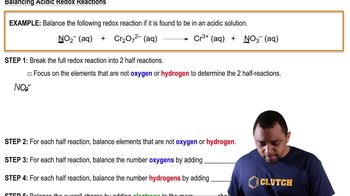Textbook Question
(b) On which side of an oxidation half-reaction do the electrons appear?
 Verified step by step guidance
Verified step by step guidance



(b) On which side of an oxidation half-reaction do the electrons appear?
Indicate whether each of the following statements is true or false: (a) If something is oxidized, it is formally losing electrons.
Indicate whether each of the following statements is true or false: (c) If there are no changes in the oxidation state of the reactants or products of a particular reaction, that reaction is not a redox reaction.
Indicate whether each of the following statements is true or false: (a) If something is reduced, it is formally losing electrons. (b) A reducing agent gets oxidized as it reacts.
Indicate whether each of the following statements is true or false: (c) An oxidizing agent is needed to convert CO into CO2.